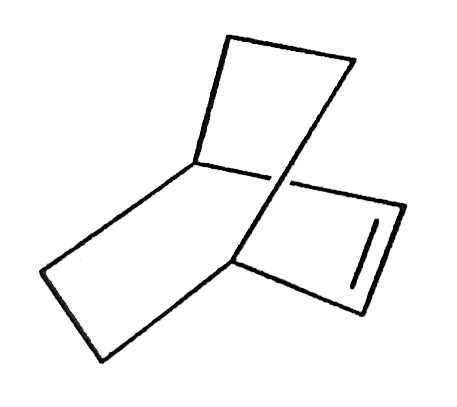A carbonyl compound (P) which gives positive iodoform test, undergoes reaction with MeMgBr followed by dehydration to give an olefin (Q). Ozonolysis of (Q) leads to a dicarbonyl compound (R ) which undergors intramolecular aldol reaction to give predominantly (S).
The structure of product (S) is:
_E01_668_O01.png)
_E01_668_O02.png)
_E01_668_O03.png)
_E01_668_O04.png)
The correct Answer is:B
To solve the problem step by step, we will analyze the transformations of the carbonyl compound (P) through to the final product (S).
Step 1: Identify Compound P
- Given Information: Compound P is a carbonyl compound that gives a positive iodoform test.
- Conclusion: This indicates that P must be a methyl ketone (or a compound that can be oxidized to a methyl ketone). A common example is 2-butanone (CH3COCH2CH3).
Step 2: Reaction with MeMgBr
- Reaction: P reacts with methyl magnesium bromide (MeMgBr), which is a Grignard reagent.
- Mechanism: The Grignard reagent adds to the carbonyl carbon of P, forming an alcohol after hydrolysis.
- Resulting Compound Q: For 2-butanone, the reaction would yield 2-butanol (CH3C(OH)(CH3)CH2CH3).
Step 3: Dehydration to Form Olefin Q
- Dehydration: The alcohol (Q) undergoes dehydration (loss of water) to form an alkene.
- Resulting Olefin Q: From 2-butanol, dehydration would yield butene (specifically, 2-butene).
Step 4: Ozonolysis of Olefin Q
- Reaction: Ozonolysis of Q (2-butene) involves treating it with ozone (O3), followed by reduction.
- Resulting Compound R: Ozonolysis of 2-butene would yield two molecules of acetaldehyde (CH3CHO), which is a dicarbonyl compound.
Step 5: Intramolecular Aldol Reaction of R
- Aldol Reaction: The dicarbonyl compound (R) undergoes an intramolecular aldol reaction. This requires at least one carbonyl and alpha hydrogens.
- Mechanism: The aldehyde group reacts with the alpha hydrogen of the other carbonyl group, forming a six-membered ring.
- Resulting Compound S: The product of this reaction is likely to be a cyclic compound, specifically 2-methyl-2-cyclopentene-1, which is predominantly formed.
Final Structure of Product S
- The final product (S) can be represented as a cyclic compound with the structure:
- A six-membered ring with a double bond and two methyl groups attached.
Summary of Steps
1. Identify P as a methyl ketone (e.g., 2-butanone).
2. React P with MeMgBr to form an alcohol (Q).
3. Dehydrate Q to form an olefin (2-butene).
4. Perform ozonolysis on Q to yield a dicarbonyl compound (R).
5. Conduct an intramolecular aldol reaction on R to yield the final product (S).
- Given Information: Compound P is a carbonyl compound that gives a positive iodoform test.
- Conclusion: This indicates that P must be a methyl ketone (or a compound that can be oxidized to a methyl ketone). A common example is 2-butanone (CH3COCH2CH3).
- Reaction: P reacts with methyl magnesium bromide (MeMgBr), which is a Grignard reagent.
- Mechanism: The Grignard reagent adds to the carbonyl carbon of P, forming an alcohol after hydrolysis.
- Resulting Compound Q: For 2-butanone, the reaction would yield 2-butanol (CH3C(OH)(CH3)CH2CH3).
- Dehydration: The alcohol (Q) undergoes dehydration (loss of water) to form an alkene.
- Resulting Olefin Q: From 2-butanol, dehydration would yield butene (specifically, 2-butene).
- Reaction: Ozonolysis of Q (2-butene) involves treating it with ozone (O3), followed by reduction.
- Resulting Compound R: Ozonolysis of 2-butene would yield two molecules of acetaldehyde (CH3CHO), which is a dicarbonyl compound.
- Aldol Reaction: The dicarbonyl compound (R) undergoes an intramolecular aldol reaction. This requires at least one carbonyl and alpha hydrogens.
- Mechanism: The aldehyde group reacts with the alpha hydrogen of the other carbonyl group, forming a six-membered ring.
- Resulting Compound S: The product of this reaction is likely to be a cyclic compound, specifically 2-methyl-2-cyclopentene-1, which is predominantly formed.
- The final product (S) can be represented as a cyclic compound with the structure:
- A six-membered ring with a double bond and two methyl groups attached.
1. Identify P as a methyl ketone (e.g., 2-butanone).
2. React P with MeMgBr to form an alcohol (Q).
3. Dehydrate Q to form an olefin (2-butene).
4. Perform ozonolysis on Q to yield a dicarbonyl compound (R).
5. Conduct an intramolecular aldol reaction on R to yield the final product (S).
Topper's Solved these Questions
- ALKENE, ALKANE & ALKYNE BOOK - ALLENCHAPTER - ALKENE, ALKANE & ALKYNE EXERCISE - EXCERSISE-1
25 Videos
- ALKENE, ALKANE & ALKYNE BOOK - ALLENCHAPTER - ALKENE, ALKANE & ALKYNE EXERCISE - EXCERSISE-2
20 Videos
- ALKENE, ALKANE & ALKYNE BOOK - ALLENCHAPTER - ALKENE, ALKANE & ALKYNE EXERCISE - EXERCISE-5[A]
68 Videos
- AIIMS 2019BOOK - ALLENCHAPTER - AIIMS 2019EXERCISE - CHEMISTRY
40 Videos
- ALKYL AND ARYL HALIDEBOOK - ALLENCHAPTER - ALKYL AND ARYL HALIDEEXERCISE - EXERCISE-05 (B)
35 Videos
Similar Questions
A carbonyl compound (P) which gives positive iodoform test, undergoes reaction with MeMgBr followed by dehydration to give an olefin (Q). Ozonolysis of (Q) leads to a dicarbonyl compound (R ) which undergors intramolecular aldol reaction to give predominantly (S).
P1.MeMgBr−−−−−−−→2.H+,H2O3.H2SO4,ΔQ1.O3−−−−−→2.Zn,H2OR1.OH−−−−−→2.ΔS
The structure of products (Q) and (R ), respectively, are:
View Solution (i)O3−−−−−−−−→(ii)Zn−H2O¯:OH−−→Δ NO. of aldol condensation product.
(i)O3−−−−−−−−→(ii)Zn−H2O¯:OH−−→Δ NO. of aldol condensation product.
View Solution
Knowledge Check
Ph−CH2−O∣∣C−OH(1)NaOH,CaO,Δ−−−−−−−−−−−−−−→(2)H⊕(A)
Product (A) is :APh−CO2HBPh−CH2−OHCPh−CH3D
But-2-ene 1.O3−−−−−−−→2.Zn,H2OPOHӨ−−−−−→ΔQPd/C−−−−−→H2R
R is :
View SolutionC6H15O6(P)O3−−−−→Zn,H2OC4H8O4(Q)Molish−−−→reagent Violet colour ring
Structure of P connote be :
View SolutionH−C≡C−HHgSO4−−−−−−→H2SO4dil.NaOH−−−−−→Δ−−→P. The final product P is
View SolutionC2H2Hg(OH)21%−−−−−−−−−−→H2SO4A[O]−−→B, B is :
View Solution Hdil NaOH−−−−→[A]H2O+−−−→Δ[B]
Hdil NaOH−−−−→[A]H2O+−−−→Δ[B]
View SolutionBenzene +Cl−CH2CH2CH3AlCl3−−→P(i)O2/Δ−−−−−−−−→(ii)H2OQ+
Phenol The major products P and Q are :
View SolutionConsider the following sequence of reactions
C2H5C≡CHCH3MgBr−−−−−→A(1)HCHO−−−−−−→(2)H2O+B
The product (B) is
View Solution
